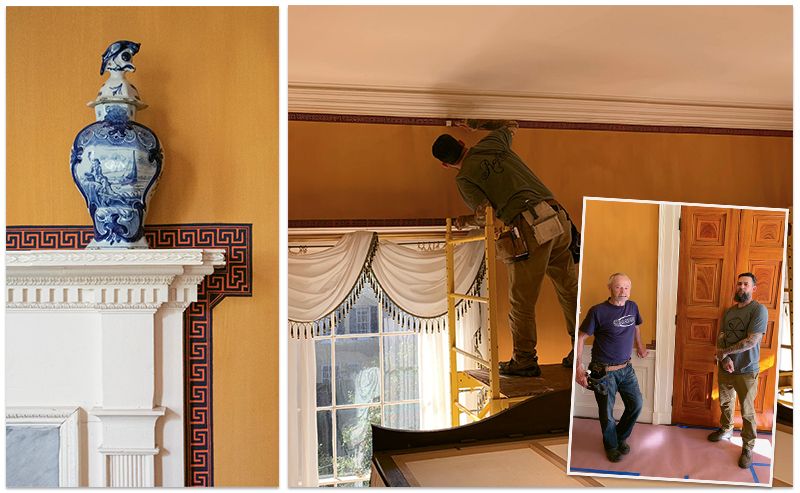Discovering the Nathaniel Russell House’s hidden decorative past

Historic Wallpaper Specialties owner Jim Yates (far right, at left) and associate Jeff Ragland applied a wallpaper border replicating one that first embellished in this bedroom around 1814.
If translating an interior designer’s style for your home seems daunting, imagine replicating a centuries-old look—with samples less than a couple centimeters in size. Historic Charleston Foundation (HCF) recently pulled off such a feat at the Nathaniel Russell House, completing the 1808 residence’s second-floor bed chamber with a wallpaper border that blasts rich orange and blue into a bold yellow space.
The project began in 2015, when HCF brought in Virginia conservator and paint analyst Susan Buck to search the room for fresh clues to its decorative past. Behind a baseboard, she found a fragment of wallpaper border in a distinctive Greek key pattern. And in a corner of the plaster walls, she discovered a tiny sample of the room’s original hue: a yellow distemper.
Though it didn’t provide the homogenous coverage of modern paints, “In the early 19th century, distemper was the best painted finish you could hope to achieve,” notes HCF Director of Museums Lauren Northup.
Eager to return the room to its premier gold, HCF brought in conservator Suzanne Collins. “It was like alchemy,” recalls Northup. “She ground French ochre powder with chalk, animal-hide glue, water, and a pinch of lamp black, adding modern artist’s matte medium to make it colorfast.” Collins applied the paint with a horsehair brush in one nail-biting day. “Painting over dried distemper destroys it, so you have to keep a wet edge—once you start, you can’t stop,” Northup explains.
The finish also leaves uneven edges—thus the need for a border. Northup spent a year searching archives for the exact paper she believes was installed around 1814. It remains a mystery.
But in Sharon Springs, New York, a 200-year-old printing block bearing a Greek key pattern sat on a shelf at Adelphi Paper Hangings, a last-of-its-kind company that’s produced wallpapers for the likes of Mount Vernon and Monticello.
Employing the same hand-printing methods they would have circa 1814, Adelphi’s artisans used the block to create a border for the room. Northup tracked down “the guy”—Jim Yates, of Tennessee’s Historic Wallpaper Specialties—skilled enough to piece together the wallpaper strips atop the fragile distemper paint.
Completed in January, the accent provides just the sort of drama early Charlestonians desired. “They weren’t inundated with artificial colors, so they felt free to be dazzling in their interiors,” explains Northup. “You wanted to make choices that showed up in candlelight.” Today’s serene greys and understated whites wouldn’t have stood a chance.